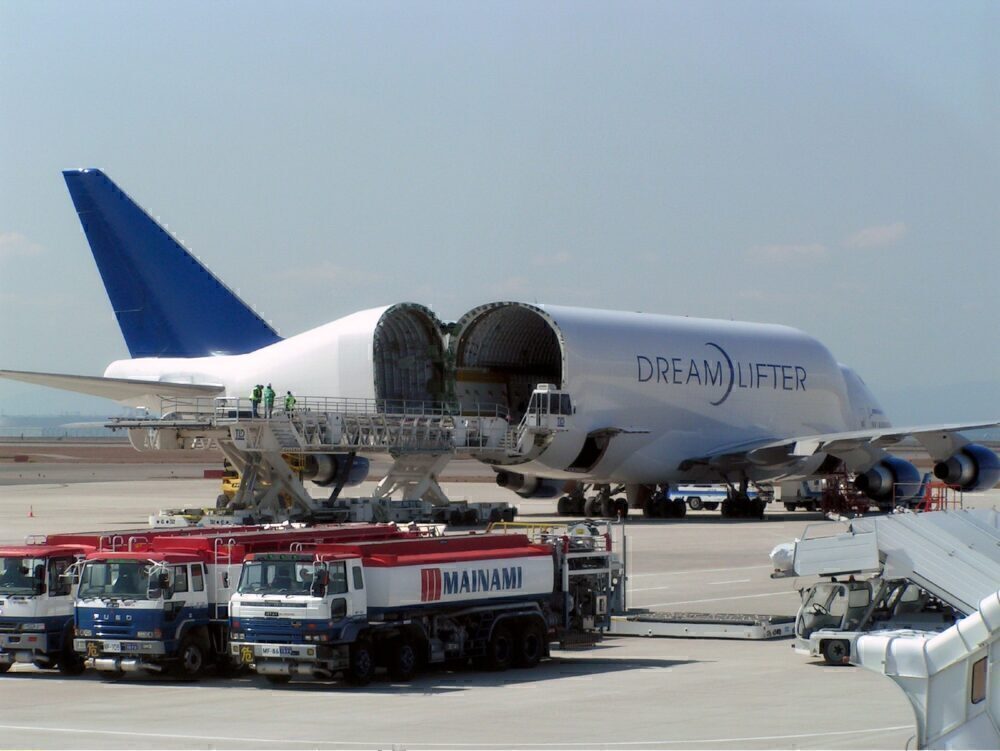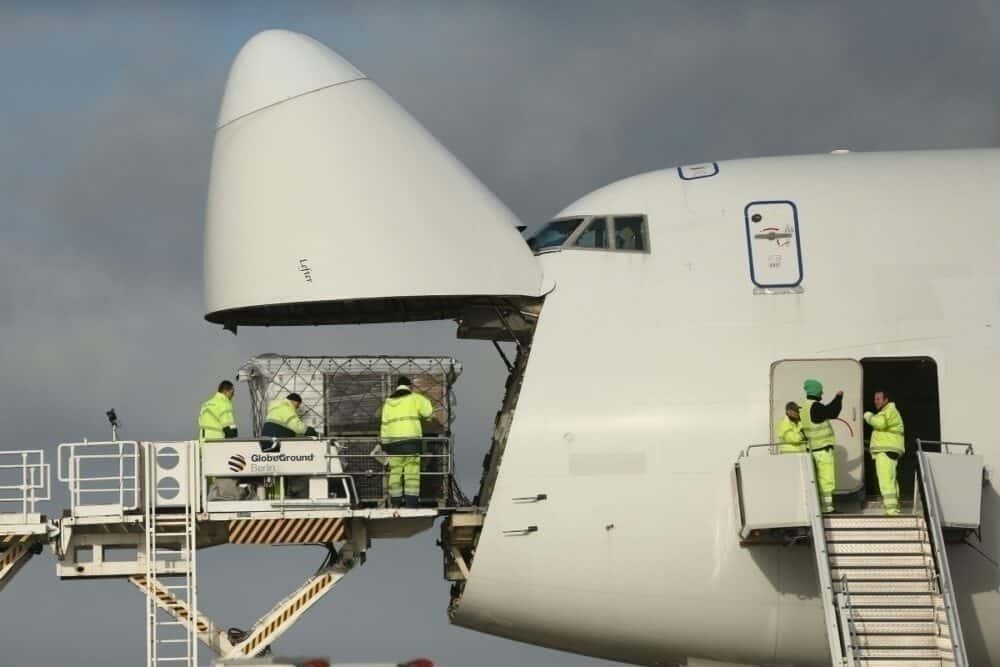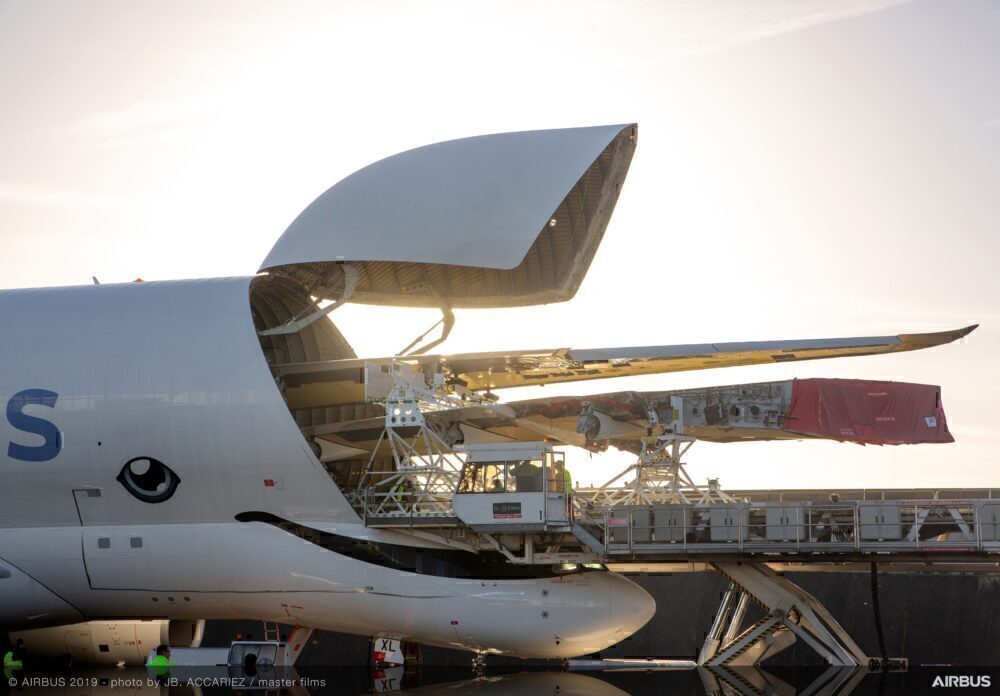The Boeing Dreamlifter is one of the most distinctive aircraft around. Its huge fuselage gives it the capacity to carry Boeing 787 parts worldwide (or other large cargo, of course). This is only part of the design changes made to its 747 airframe, though. The re-engineered tail is another major difference, as this article explores.

The Boeing Dreamlifter
The Dreamlifter, also known as the Large Cargo Freighter (LCF), is Boeing’s high-capacity freighter. It came about during the planning for the construction of the 787. Boeing used suppliers far afield, including Japan and Italy, and needed a way to transport components to its US-based factories. Land and sea transport would take a long time (and be very complex), and existing freighters were not large enough.
The solution was to build its own fuselage transporter, based on the 747-400 airframe. This was introduced into service in 2007, and four have been built.
Airbus has done the same for transporting its aircraft components. The Beluga is based on the A300-600 and was introduced in 1995, with five delivered up to 1999. The larger BelugaXL, based on the A330-200, follows on, with deliveries starting in 2020. It has a higher overall cargo space than Boeing’s Dreamlifter and will be used mainly to transport A350 components.

Stay informed: Sign up for our daily and weekly aviation news digests.
Loading cargo
Expanding the fuselage of these transporters to take their huge cargo is an engineering challenge in itself; getting the cargo in and out is another. The 747-400F has a lifting cargo nose, but this would not be sufficient to provide full access to the enlarged fuselage. Side cargo doors even less so.

Airbus’ solution with the Beluga and BelugaXL is a full opening front cargo door above a lowered cockpit section. It’s certainly distinctive! Boeing instead chose an opening tail section, adding the unique ability for the entire tail section to swing open.

Swinging the tail
Adding the functionality for the tail to open is not as easy as it sounds. This was not something done before on a commercial aircraft and proved quite a challenge.
SAE International looked in some detail at the engineering challenges presented. These included:
- Developing a secure and reliable alignment and latching solution
- Ensuring operation in environmental extremes (including high temperate and strong winds)
- Providing correct load transmission from the tail to the fuselage
The solution is the full swinging tail, measuring approximately 29 by 23 feet, that we see today. This is hinged on the left-hand side of the aircraft. Two actuators at the rear of the fuselage provide hydraulic power to move the opening tail section.
And a proprietary latching system uses 21 locks arranged right around the intersection to lock it into place. This is based on a system originally designed for a Boeing 777 folding wing proposal (according to reporting by Boeing), with additional support from Gamesa Aeronautica of Spain.

Ensuring this remains sealed and locked when in flight is critical, of course. The fuselage section is not pressurized (only the front section, forward of an added bulkhead is), but any issues with locks or sealing could be catastrophic. The locking system can only be activated using ground support equipment.
Cargo is loaded using custom-built cargo loaders and guided into place with a laser guiding system located at the swing opening.
You can see some of the swing tail details up close in this video from Sam Chui.
Other modifications to the tail
The swinging opening is the most noticeable modification, but there is more. As well as enlarging the fuselage, it was also extended at the tail section, with an additional conical extension section.
Boeing also increased the height of the tail section by around five feet. This aids control of the aircraft following its other structural modifications.

There is also no APU in the tail of the aircraft (as other 747 aircraft have). There is some interesting discussion of this on pprune.org, where it is sensibly suggested that the removal was mainly to avoid running a fuel line through the hinging door. This leaves the Dreamlifter reliant on an external supply for engine start.
The Dreamlifter is an amazing aircraft, both for its size and additional engineering challenges that were overcome. Feel free to discuss these further in the comments.
[ad_2]
Source link



